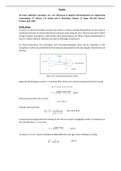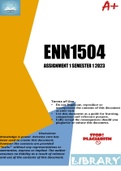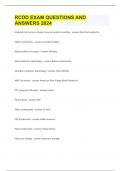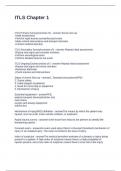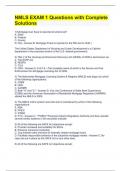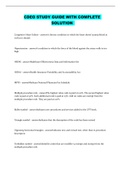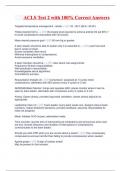10 MCQ’s- 8/10
11- 3/5
Transferred malice is where the mens rea for a crime if transferred from the intended victim to the
actual victim (Latimer). This however only works on similar crimes. In this scenario, Alfred has
committed a battery against Charlie despite him intending to hit Bert. As he still committed a
battery, he would still be charged as the mens rea is still intention or recklessness (Cunningham) to
apply unlawful force onto another (Venna).
12- 5/5
Theft is the dishonest appropriation of property belonging to another with the intention to
permanently deprive the other of the item s.1 Theft Act 1968. For a theft to become a robbery force
must be used immediately before or during the theft (Hale). In this scenario the theft had already
been committed before Beth fell into Alex, therefore disproving the actus reus. The mens rea also
requires that force be intended to commit the theft. In this scenario the force was not intended as
Beth stumbled into Alex, showing a clear lack of intent in the action. Therefore the mens rea cannot
be satisfied and as such it was not a robbery.
13- 8/10
Carl may be able to rely on the partial defence of loss of control under s.54(1) Coroners and Justice
Act 2009.
The first element is loss of self-control (s.54(2)) which does not have to be sudden. The case of Ballie
added there could be a time delay. In this scenario Carl lost self-control when he heard Deena
making critical comments about him and then kissing Errol in front of him.
The next element is the qualifying trigger (s.55) which can be either fear (Sian), anger (Zebedee) or
both. For Carl it is anger as Deena was making critical comments and comparing him unfavourably to
another man, which could be seen as being of a grave nature and give Carl a sense of being
justifiably wrong. However, Deena kissing carl along does not qualify as sexual infidelity is an
exclusion (Clinton). Carl also had a knife on him at the time which could also be an exclusion under
revenge (Ballie).
The objective test is used by the jury to determine loss of control. Would someone of the
defendant’s age and sex with a reasonable degree of tolerance react in the same or similar way? In
this case it is likely that someone the same age and sex of the defendant would react in the same or
similar way. The case of Holley made it so that only age and sex should be considered.
Assuming the defence worked, Carl would be given a discretionary life sentence.
14- 9/10
Earl could rely on the full defence of insanity which is were the defendant is unable to form the
mens rea.
The test for insanity is applied through the M’Naughten rules and are made up of three questions.
The first one is defect of reasoning; was the defendant’s power of reasoning impaired (Clarke). In
this scenario it can be argued that the defendants reasoning was impaired as he has not taken his
insulin for several days. The second element is caused by illness of the mind; this can either be
mental (Burgess) or physical (Kemp). In this scenario it could be argued that it is both mental as he
has not had insulin and as such he forgot the entire incident, showing that he has no control over his
, 634312
mind or reasoning, and it can by physical as the lack of insulin has led to Earl having no control over
his body. The final element is the defendant must not know the nature and quality of his action
(Windle). In this scenario it is clear that the defendant does not know the nature and quality of his
action as he had forgot the entire incident almost immediately after it happened. Despite the
M’Naughten rules being satisfied Earl may not be able to rely on the defence as he chose not to take
his insulin for a number of days, meaning it was self-induced.
If the defence was to succeed, Earl would be found not guilty by reason of insanity and receive a
hospital order with no time limit under the Criminal Procedure (Insanity and unfitness to plead) Act
1991 amended by s.5 Criminal procedure (Insanity) Act 1994.
15- 26/30
Jez has committed the statutory offence of theft, which is defined as the dishonest appropriation of
property belonging to another with the intent to permanently deprive the other person of it under
s.1 Theft Act 1968.
The first element of the actus reus (AR) for theft is appropriation (s.3). this means to assume the
rights of the owner (Morris). Jez has assumed the rights as the owner of the watch as he was given it
by Henry to keep in exchange for £2000. The next element of the AR is property (s.4) which is any
moveable item (Kelly and Lindsey). The watch is a moveable item as it can be picked up and taken to
different places. The final element of the AR is belonging to another (s.5) this is though possession
and control (Turner No 2) and proprietary rights and interests (Webster). In this scenario, Jez has
possession and control of the watch as it has been given to him. Therefore, the AR has been
satisfied.
The first element of the mens rea (MR) is dishonesty s.2. This is determined by the Ghosh test and is
comprised of two questions. The first question is was the defendant’s actions considered dishonest
by the standards of a reasonable and honest person? In this scenario Jez’s actions can be seen as
dishonest as he did not pay the £2000 he promised Henry for the watch. The second question is if so,
did the defendant know that his actions were considered dishonest by the standard of a reasonable
and honest person? In this scenario the defendant may not have known that his actions were
dishonest as he promised to pay Henry the money and they were close friends at the time. The case
of Ivey (2017) removed the second limb of the test meaning that the second question is obiter to
most cases. The final element of the MR is intention to permanently deprive (s.6), in this case to
treat the item as their own regardless of the owners’ rights s.6(1)(a) (Velumyl). However, in this
scenario Jez did not take the watch intending to permanently deprive Henry of the money as it is
stated that Henry only became furious when he began to suspect that Jez was not going to pay for
the watch, proving that at the point when Henry gave Jez the watch he was not planning on stealing
it form Henry. Therefore, the MR has not been proven.
If Jez was to be found guilty he would be sentenced to 7 years imprisonment.
In relation to Gill, she has committed the statutory offence of theft, which is defined as the dishonest
appropriation of property belonging to another with the intent to permanently deprive the other
person of it under s.1 Theft Act 1968.
The first element of the actus reus (AR) for theft is appropriation (s.3). this means to assume the
rights of the owner (Morris). Gill has assumed the rights as the owner of the watch as picked it up
and threw it into the woodland. The next element of the AR is property (s.4) which is any moveable

